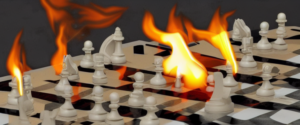Chess is a strategic board game that has been played for centuries. It is a game that requires both strategic thinking and tactical skills. Tactics are a set of moves or combinations that lead to a specific goal, such as capturing an opponent’s piece or putting them in checkmate. This is a list of the most fundamental tactical ideas:
- Forks: A fork is a move that attacks two or more pieces simultaneously, forcing the opponent to choose which piece to save. A well-executed fork can give the player a significant advantage. For example, a knight placed in a central square can threaten both the queen and the rook simultaneously. If the opponent moves the queen to safety, the rook can be captured.
- Pins: A pin is a move that restricts the mobility of a piece by attacking it with a more valuable piece. The pinned piece cannot move without leaving a more valuable piece unprotected. A common example of a pin is when a bishop pins a knight against the king. The pinned knight cannot move without putting the king in check.
- Skewers: A skewer is a move that attacks a valuable piece that is hiding behind a less valuable piece. The less valuable piece is forced to move, leaving the more valuable piece exposed to capture. For example, a queen can skewer a rook and a king that are lined up on the same file.
- Double Attacks: A double attack is a move that attacks two or more pieces simultaneously, forcing the opponent to choose which piece to save. Unlike a fork, the double attack does not require the attacking piece to be in a central position. For example, a bishop can attack both a pawn and a rook on the same diagonal.
- Discovered Attacks: A discovered attack is a move that uncovers an attack by another piece. The attacking piece moves out of the way, revealing an attack by another piece behind it. This can be particularly effective when the discovered attack is against the opponent’s king. For example, a knight can move to reveal an attack by a bishop on the opponent’s king.
- Sacrifices: A sacrifice is a move that involves giving up a valuable piece in exchange for a more significant advantage. Sacrifices can be particularly effective in the endgame when a player is trying to checkmate their opponent. For example, sacrificing a bishop or a knight can lead to a quick checkmate if the opponent is not careful.
- Overextended Pawns: How to punish reckless advancesIn essence, an advanced pawn can at times be stretched too far, resembling a troublesome presence for the opponent. Nevertheless, pushing the pawn forward hastily without reason amounts to an unwise overextension. Distinguishing between these scenarios falls to the discernment of a skilled player.
- King Walk: The wandering monarchA king walk, which is also referred to as a king march, steel king, or wandering king, involves an intriguing maneuver wherein the king embarks on a significant journey to a distant part of the board during the middlegame or opening phases of the game.
- The Octopus Knight: Eight tentacles in enemy territoryOctopus is the nickname of an assertive knight that ventures boldly into enemy territory, strategically poised far from the edges of the battlefield, extending its influence in all eight directions akin to the tentacles of an octopus.
- Hanging Pawns: Strength or weakness?Hanging pawns, a significant pawn structure in chess, arise when two pawns are positioned on adjacent files without any other pawns to support or defend them. While they often form on the c- and d-files, they can also manifest on different files.
- Flank Opening: What to play and what to avoidA flank opening in chess is a strategy employed by White, characterized by focusing on one or both sides of the board, away from the central d and e files. In this approach, White adopts a hypermodern style, opting to attack the center with pieces rather than occupying it with pawns.
- Arabian Mate: Deadly combination of rook and knightIn the Arabian Mate, the knight and the rook form a strategic alliance to corner the opposing king on one of the corners of the chessboard. The rook positions itself on a square adjacent to the enemy king, thereby blocking any diagonal escape routes and enabling it to deliver checkmate.
- Tame the hedgehog: Development under shelterThe Hedgehog is a strategic setup in chess often utilized by Black and can emerge from various openings. It involves exchanging Black’s c5 pawn with White’s d4 pawn and then positioning pawns on a6, b6, d6, and e6.
- Discovered Attack: Win by surprise discoveriesCertainly, you must have observed the frequent occurrence of the discovered attack, particularly in the form of a discovered check, throughout our past articles and analyses. Therefore, the concept should not come as a significant surprise.
- Philidor Sacrifice: Trade a piece for pawnsA Philidor sacrifice, endorsed and employed by the renowned chess player François-André Danican Philidor, involves sacrificing a minor piece in exchange for one or two pawns. This strategic move is strategically employed to enhance pawn mobility, serving as compensation for the sacrificed material.
- Self Stalemate: The last resortThe strategy employed in such scenarios always relies on the distinctive movement capabilities of pawns, which restrict them from moving backward, thereby leading to mutual blockades on the same file.
- King Hunt: No breathing spaceA king hunt in chess refers to a strategic pattern where the opponent’s king becomes vulnerable and is relentlessly pursued with a series of check moves. At times, the king is lured away from its initial position and eventually cornered in hostile territory, leading to checkmate.
- Family Fork: Attack three or more piecesWhen a fork involves attacking the enemy king, queen, and possibly other pieces, it can be referred to as a “family fork” or a “family check” since it puts multiple members of the opponent’s “family” (king and queen) in jeopardy.
- Exchange variations of openingsExchange variations refer to chess openings where the players opt to trade off pieces, usually pawns or minor pieces (knights and bishops), in the initial moves.
- A tempo helps speed up the progressOne way to gain tempo is by simultaneously developing a piece and delivering a check. However, if the opponent can counter the check by developing their own piece, the overall effect may be neutral. On the other hand, if the check can be blocked by a beneficial pawn move that also forces the checking piece to retreat, it is possible to even gain an advantage by losing a tempo.
- Clearance Sacrifice: We have clearance, Clarence!A clearance sacrifice is a tactical maneuver in chess where a player willingly sacrifices a piece or pawn in order to clear a particular square or line for another piece’s activity. The sacrificed piece is typically blocking the path of a more valuable piece or preventing a tactical sequence from unfolding.
- Zwischenzug: The powerful intermezzoThe zwischenzug, also known as an intermezzo or in-between move, is a strategic maneuver in chess where a player deviates from the expected move, typically a recapture, by first making a different move that immediately threatens the opponent.
- How can you x-ray your opponent?The x-ray tactic can be used in a variety of ways, and its effectiveness depends on the specific position and arrangement of the pieces on the chessboard. Skilled players often employ x-ray attacks as part of their tactical combinations and strategic plans.
- Undermining: An effective tactic to break through defensesUndermining, also referred to as guard removal or defender removal, is a strategic maneuver in chess where a defensive piece is captured, thereby exposing one of the opponent’s pieces as unprotected or inadequately protected.
- Learn to triangulate your opponentTo master the art of triangulation, chess players must develop an intuitive understanding of endgame dynamics, precise calculation abilities, and strategic planning. Familiarity with pawn structures, king activity, and tactical patterns is essential for recognizing potential triangulation opportunities.
- Swindle: Extricate yourself from hopeless positionsPlayers can enhance their likelihood of executing a swindle by employing certain strategies, such as maintaining an active playing style and taking advantage of time pressure. While swindles can take various forms, common themes include employing stalemate tactics, utilizing perpetual checks, and executing unexpected mating attacks.
- Backward pawns: How to exploit themSo, the general idea is to avoid creating backward pawns of your own. Backward pawns generally pose a positional drawback since they lack support from other pawns, making them vulnerable.
- Learn the power of zugzwang: Why is it so important?So, what does this word mean? Zugzwang refers to a condition observed in games like chess, where a player is compelled to make a move but is placed at a disadvantage as a result.
- Skewer: How to win by a reverse pinA skewer in chess is an offensive maneuver that targets two pieces in a straight line, much like a pin. However, there is a fundamental distinction between the two tactics. In a skewer, the higher-value piece is directly threatened, whereas the lower-value piece is positioned behind it.
- Rooks on the seventh rank are powerfulHaving a rook positioned on the seventh rank, which is also the second rank of the opponent’s side, is commonly acknowledged as a potent tactical advantage. This is because such a rook poses a serious threat to the unadvanced pawns of the opponent, and also restricts the movements of their king.
- Pin them down: Win by the most powerful tacticThe act of creating a pin by moving the attacking piece into position is known as pinning, and the restricted defending piece is said to be pinned. Only pieces that can move along a horizontal, vertical, or diagonal line, such as the bishop, rook, or queen, can execute a pinning maneuver.
- Prophylaxis: A precaution in good timeProphylaxis in chess refers to the strategic use of moves by a player to forestall their opponent’s potential actions. These moves, commonly known as prophylactic moves, are not only intended to enhance one’s own position, but also to limit the opponent’s ability to enhance theirs.
- Fortress and Defensive Perimeter: Draw by jammingAnother intriguing usage of a fortress is called the Defensive Perimeter. A Defense Perimeter is distinct from other fortification techniques in that it can be established during the middlegame, even when numerous pieces are still present on the board.
- Interference: Win by unexpected blocks of the linesInterference in chess happens when a piece is sacrificially placed between an attacked piece and its defender, interrupting their line of communication. This tactic is infrequent and can be easily missed.
- Pawn break: How to disrupt the defense lineWhat exactly is meant by a pawn break? Essentially, it refers to any pawn movement aimed at interfering with the opponent’s pawn structure in some manner. This tactic has various uses, and there are particular scenarios where it can prove to be particularly advantageous.
- Half-open file: Pressure your opponentA half-open file, also known as a semi-open file, is a chess term used to describe a file where pawns of one color are absent. Such a file can be strategically advantageous for a player, as it can provide an open line of attack for their rook or queen.
- Perpetual Pursuit: Another way to secure a drawEarlier, we discussed how perpetual check can be utilized as a tactical strategy to secure a draw in a seemingly dire situation. Nevertheless, it may not always be feasible to continually target the adversary’s king, particularly during endgames that lack major pieces (queens and rooks). Fortunately, a comparable approach called perpetual pursuit can be implemented if certain conditions are met.
- Outpost: How to improve your positional play?Okay, here’s the definition. A square positioned on the fourth, fifth, sixth, or seventh rank that is shielded by a pawn and impervious to being targeted by an opposing pawn is known as an outpost. Conversely, such a square becomes a vulnerability for your opponent, and it is called a hole from their perspective.
- Paul Morphy: Learn from one of the best of all timePaul Morphy (June 22, 1837 – July 10, 1884) is considered one of the greatest chess players of all time. His play was characterized by his aggressive style, his excellent tactical skills, and his ability to quickly assess the strengths and weaknesses of his opponents. In this article, we will show a few of his well-known masterpieces, with a special focus on the tactical strikes.
- Strong doubled pawns: Learn to recognize themIn most situations, these pawn structures are usually weak points, and a good player can build the strategy on exploiting them. However, every rule has an exception, and even doubled pawns can represent a strength under specific circumstances.
- Fork: Overload your piece in a good wayA fork is a strategy commonly used in chess, whereby a single piece is used to attack two or more opposing pieces simultaneously. The primary objective of the attacker is to capture at least one of the targeted pieces, and it is often challenging for the defender to counteract every threat.
- Deflection: Target the overloaded piecesThe deflection tactic is a powerful tool in a chess player’s arsenal. By distracting your opponent’s pieces and diverting their attention away from their intended goal, you can gain a significant advantage on the board.
- Overloading: Who watches the watchers?Overloading is often used with other tactics, such as pins, forks, or discovered attacks, to create a powerful combination that can win material or force a decisive advantage. It is an important concept to understand for intermediate and advanced players, and is often used in high-level chess games.
- Windmill: Grind up your opponent’s defensesA windmill, also known as a seesaw, is a strategic maneuver in chess where a player repeatedly captures their opponent’s pieces while also setting up a sequence of checks that can’t be avoided.
- Pawn Storm: A direct way to break through enemy defensesThe success of a pawn storm depends on several factors, including the position of the opponent’s pieces, the strength of their pawn structure, and the timing of the attack. A well-timed pawn storm can be devastating, as it can force the opponent to make difficult decisions and create weaknesses that can be exploited.
- The Exchange Office: Sacrifice a rook for a minor pieceThe exchange sacrifice can be a risky move, as the rook is typically considered to be more valuable than a minor piece. However, it can also be a powerful tactic when used effectively, and is often employed by experienced players as a surprise attack or to gain a decisive advantage in a critical position.
- Bishops versus knights: What is stronger and why?As we know, the value of each piece depends on its mobility, the potential threats it poses, and its ability to control the board.
- Domination: An effective way to restrain your opponentDomination occurs when a player controls all the squares that an enemy piece can move to. For instance, if a player’s knight is surrounded by the opponent’s pawns, and there are no squares that the knight can move to without being captured, the knight is said to be dominated.
- When can you start a risky attack?However, it’s important to remember that starting a risky attack can also backfire and lead to a disadvantageous position or even a loss. Therefore, it’s crucial to weigh the risks and rewards carefully.
- How many pieces would you trade for a queen?By understanding the strengths and weaknesses of each piece, you can make better decisions on the board, anticipate your opponent’s moves, and create winning strategies.
- Luft: Give your king some air! Don’t get surprised on the back rankLuft is a term used in chess to refer to the space or square created by moving a pawn, which provides an escape route for the king (often after castling), particularly when this space is deliberately created to prevent a back-rank checkmate.
- Isolated pawns and how to exploit themOne of the main ways to exploit an isolated pawn is to attack it. By attacking an isolated pawn, you force your opponent to either defend it with a more valuable piece, such as a knight or bishop, or to leave it undefended.
- Desperados in chess: How to save the gameIn chess, a desperado is a piece that is doomed to be captured, but can capture one or more enemy pieces before it is taken. The term “desperado” comes from Spanish, where it means “desperate” or “hopeless”.
- Protected passed pawn: A path of a steamrollerA passed pawn that is protected by its own pawns is called a protected passed pawn. A pair of connected passed pawns is sometimes called a steamroller.
- Decoy: The ultimate weapon of the attacking playerOne of the most common decoys in chess is the queen sacrifice. In this tactic, a player offers their queen to their opponent in exchange for a material advantage or a checkmate.
- Greek gift sacrifice: Timeo Danaos et dona ferentesIn this case, the attacking player offers a bishop sacrifice to break through the opponent’s defense and lure out their king to eventually checkmate it or at least gain a significant material advantage.
- Boden’s Mate: Peruvian Immortal and moreBoden’s Mate is characterized by a king being mated by two bishops on criss-crossing diagonals, with possible flight squares blocked by friendly pieces. Samuel Boden, for whom the mate is named, administered an early example of it in the friendly game Schulder–Boden, London 1853.
- Cross-Check: The counter-offensive is the best defenseIn chess, a cross-check is a tactic in which a check is played in response to a check, especially when the original check is blocked by a piece that itself either delivers check or reveals a discovered check from another piece.
- Artificial Castling: Protect your king by handArtificial castling, also known as castling by hand (or manual castling), is a positional maneuver used by players that want to achieve a castled position without the use of castling.
- Alekhine’s Gun: Unleash an aggressive heavy battery to crush opponentsHow can you defend against this strong attack formation? Well, the most straightforward way is to prevent the opponent from creating it in the first place. It shouldn’t be too difficult because to place both rooks and a queen on a single file usually requires a long sequence of moves. The intention to build the battery can be spotted at the early stage, so you have enough time to counter it.
A player who understands and can execute these tactics will have a significant advantage over their opponent. Learning and practicing these tactics can help players become more effective and efficient in their gameplay. So, whether you are a beginner or an experienced player, mastering chess tactics is a must.






















































